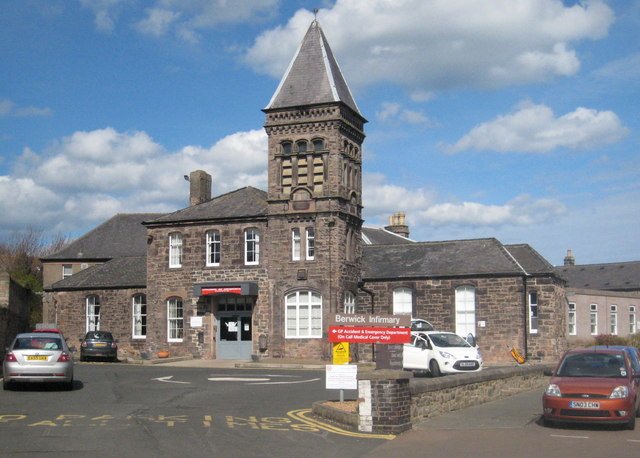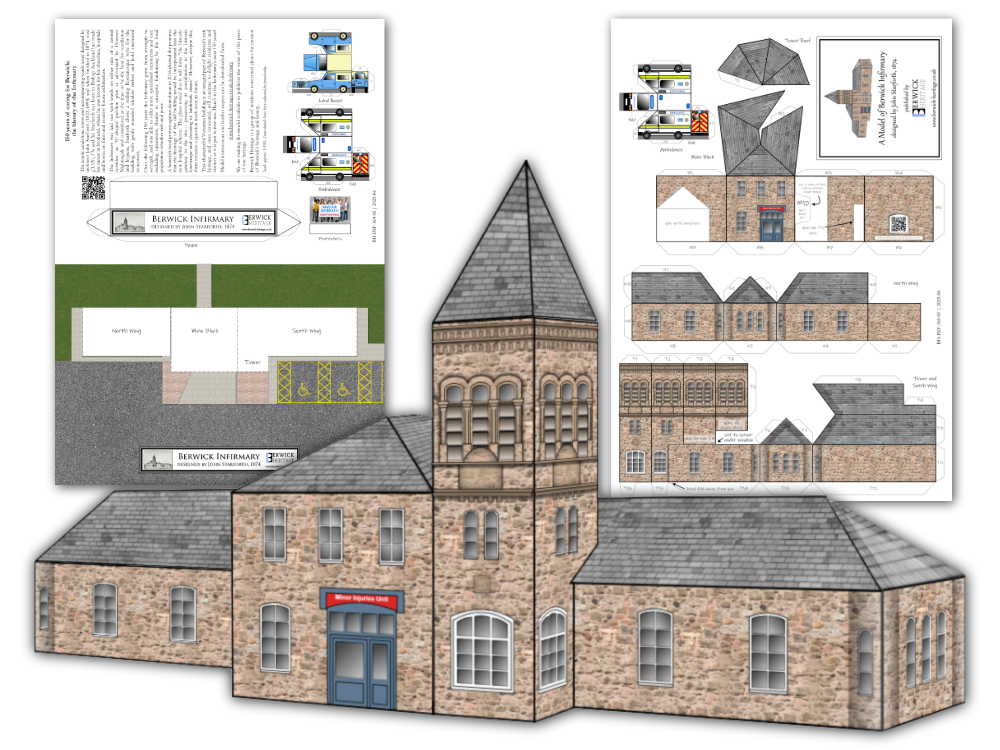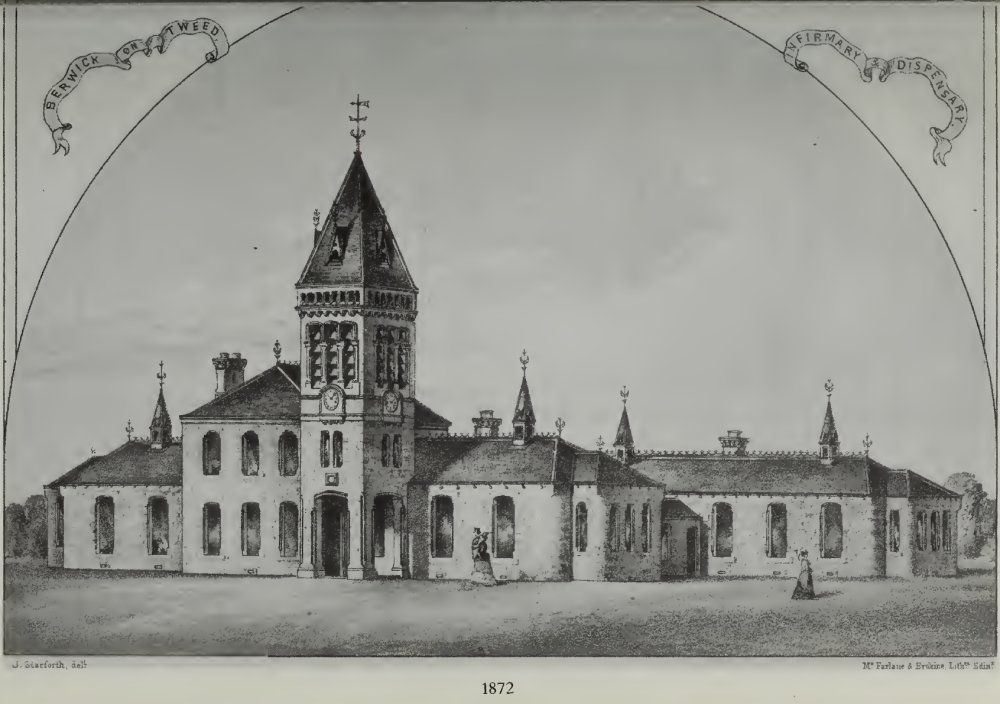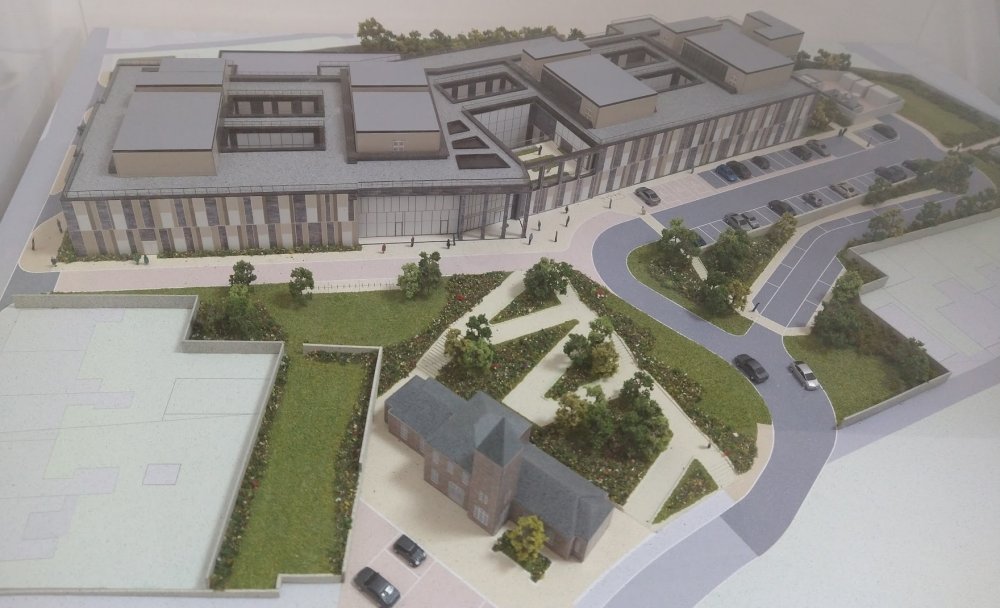Overview | History | Press | Resources | Timeline
NEW: On 25th September 2025, Northumbria Healthcare NHS Foundation Trust announced its intention to retain only the bare bell tower - not the main block and two wings that they previously committed to retaining. This broken promise is an outrageous betrayal of the commitments they made in order to get the original application through planning. This is pure tokenism and we will be campaigning against their new planning application. PLEASE SIGN THE PETITION TO SAVE THE INFIRMARY FRONT. See also our suggestion that the Infirmary front could be made into a winter garden.
We have responded to Northumbria Healthcare's announcement paragraph by paragraph.


The front of Berwick Infirmary

New! Our card model of the Infirmary is now available to download and make.
The Berwick Infirmary was completed in 1874, from a design by the architect John Starforth. It was extended several times over the years. The front is dominated by a tower - does it actually contain a bell? It certainly looks as though it should have one. If you look at the original design below, and compare it with the photograph above, you can see where a clock face used to be, so it may well have chimed. The entrance in the tower has become a window, while a large new entrance has been made in the administration block. Otherwise, the original design remains very recognisable despite the adaptations.
Historic England summarises the construction thus: "It comprised two ranges linked by a corridor, each with a pair of single-storeyed pavilion wards, one flanking a two-storey administration block with attached tower. Numerous additions."
In 2016, plans were made for a new hospital and the bell tower and adjoining wings were deemed surplus to requirements. Councillor Hazel Bettison launched a petition which attracted over 400 signatures, and many comments from people outraged that the landmark was under consideration for demolition. The old building was saved for the time being, and appears in the model of the new hospital housed within the building itself.

Drawing of John Starforth's Infirmary Design
On 25th September 2025, Northumbria Healthcare NHS Foundation Trust announced its intention to retain only the bare bell tower - not the two wings that they previously committed to retaining.
The retention of the main block and two wings that are under threat was part of a compromise that the people Berwick agreed to, as partial compensation for introducing a large, intrusive modern building into the conservation area. Indeed, their 2020 application is fulsome in its praise of what would be kept as a gateway to the new hospital.
The Trust must keep to their promise and retains the front. This will allow the building to continue to have a purpose - a stranded tower will have no practical potential and is therefore vulnerable to further calls for demolition. The tower also loses architectural and historical integrity by being stripped of all context. And it is not justifiable for the very small amount of land gained. Given the impact that the new hospital has on the Town Walls, the least we can do is to honour the memory of the old hospital and mitigate the dominating modern hospital building.
We do not believe that the secretive talks the Trust has held constitute due diligence in finding an alternative use. Besides, predicating retention on finding a tenant before renovation was never part of the original application.
This substantial erosion of Berwick's heritage cannot be allowed to happen.

Berwick Community Hospital Model
As the new hospital grows apace, it’s worth remembering that the oldest part of the Infirmary is now 150 years old.
Before the National Health Service was established in 1948, voluntary hospitals like Berwick Infirmary were vital in providing essential medical care to those in need.
The iconic sandstone tower and accompanying wards were designed by architect John Starforth (1822-1898) and when finished in 1874, cost £3,320, 13s and 3d. Starforth was born in Bishop Auckland but made his career in Scotland, where he was known for his churches, hospitals and books on farm and country house architecture.
The Infirmary is laid out with wards on either side of a central corridor, an ‘H’-shaped pavilion plan as advocated by Florence Nightingale and considered at the time to be the best for ventilation and hygiene. “The first principle of hospital construction is to divide the sick among separate pavilions,” Nightingale wrote in her 1863 Notes on hospitals. Starforth chose a striking Italianate style for the building, with gently rounded window arches and bold rusticated stonework.
Over the following hundred and fifty years the Infirmary grew from strength to strength, and was able to offer more specialised treatments and care, thanks to energetic fundraising by the local population. An operating theatre was added in 1908, and the 1911 Verandah Ward was funded by the Tweedmouth Co-operative Society.
Both rich and poor made their contributions, and these ranged from home-grown vegetables to golden guineas. Clubs and associations played a key role, most notably through the Berwick Infirmary Football Cup, an important local football league. While there were significant donations from aristocratic figures like Lady Jerningham, who funded much of the original 1874 building, this wasn't just elite philanthropy but a cause that resonated with everyone in Berwick.
At the height of the depression in 1932, people dug deep and money was found for the cause, with an army of collectors and big events such as the Infirmary Cup football match. The accounts diligently note every last penny received, and the chairman in his annual report also mentions the gifts in kind of “fruit, flowers, vegetables, game, books etc.” He goes on to say that such “gifts are much appreciated by the patients. We should particularly like to mention the splendid wireless installation provided by the Berwick Rotary Club.” He concludes that the Infirmary “has an ever-open door policy” and “for over a century, through good times and bad, has ministered to the sick and suffering.”
A heartfelt local protest against demolition in 2016 ensured the frontage of the old building would be incorporated into the new hospital scheme. The plans noted that it will form “the historic gateway to the site… preserving its contribution to the historic townscape and elevating its landmark status.” This charming Victorian building is an integral part of Berwick’s rich heritage, and once renovated, will continue to delight residents and visitors as it is put to new use. Here’s to the Infirmary’s next one hundred and fifty years!
Application to retain part of Berwick Infirmary's bell tower building to be submitted, 25th September 2025
Berwick Infirmary opens museum exhibition dedicated to its healthcare history, 9th September 2024
Health chiefs celebrate as new Berwick hospital development approved by Northumberland County Council, 1st December 2020
Planning application goes in for new Northumberland hospital in Berwick, 15th June 2020
Northumbria Healthcare NHS Foundation Trust proposes to use the Berwick Infirmary site for the new hospital instead of proposed sites in Tweedmouth or Seton Hall, 8th May 2019
Chronicle Live article on the original petition, 26th July, 2016
Timeline of the Infirmary and new hospital
Infirmary Poster 1: please sign our petition
The Northumbria Healthcare NHS Foundation Trust announces that only the Infirmary tower will be kept, 25th September 2025
Architect's comment on the application's approval, 1st December 2020, including retention and refurbishment of the bell tower for community use (the whole front being shown in the plans)
20/01882/FULES: Berwick Community Hospital: Demolition of existing Berwick Infirmary and erection of new Community Hospital (Use Class C2) with integrated healthcare and clinical facilities including a GP surgery (Use Class D1), together with associated hard and soft landscaping, access arrangements, servicing and retention of existing Bell Tower
Northumberland Historic Environment Record for the Berwick Infirmary
Berwick Dispensary and Infirmary, 1814-1898, an article by Dr Alan Binnie